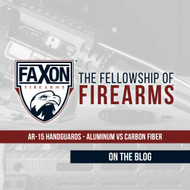AR-15 Handguards - 6061 Aluminum vs. Carbon Fiber
Posted by Faxon Firearms Staff on Jul 12th 2023
When it comes to selecting the right handguard for your AR-15, understanding the materials used in their construction is essential. Two popular options for AR-15 handguard material are 6061 aluminum and carbon fiber. We'll investigate the similarities and differences between these materials and help to answer many common questions.
6061 Aluminum Handguards:
6061 aluminum is a widely used alloy known for its strength-to-weight ratio and mechanical properties. Faxon Firearms offers a range of handguards made from this material. Here are some key points to consider:
Strength and Durability:
6061 aluminum handguards provide excellent strength and durability, allowing them to withstand the rigors of firearm use. The aluminum construction ensures solid protection for the barrel and other internal components.
Weight:
While not as lightweight as carbon fiber, 6061 aluminum handguards strike a balance between strength and weight. They offer sufficient rigidity while keeping the overall weight manageable, making them suitable for a variety of shooting applications.
Heat Dispersion:
Aluminum is a good conductor of heat, enabling efficient heat dissipation from the barrel. This property helps prevent overheating during prolonged shooting sessions, maintaining consistent performance.
Machineability:
6061 Aluminum is a very easy to work material so it can be formed or cut into a wide variety of shapes. This allows handguards to be made in multiple configurations with different mounting points, MLOK® slots, picatinny rails, or even just different lines/cuts for aesthetic purposes!
Carbon Fiber Handguards:
Carbon fiber is a composite material consisting of thin carbon fibers embedded in a polymer matrix. Faxon Firearms also offers carbon fiber handguards, which bring several unique advantages to the table:
Lightweight Construction:
Carbon fiber handguards are significantly lighter than their aluminum counterparts. Faxon Firearms' carbon fiber technology ensures that their handguards are lightweight without compromising strength, reducing overall firearm weight, and enhancing maneuverability.
Superior Strength-to-Weight Ratio:
Carbon fiber boasts exceptional strength-to-weight properties, making it a popular choice in high-performance and competition applications. Faxon Firearms utilizes carbon fiber's innate rigidity to provide a solid platform for accessory attachment while keeping the firearm lightweight and agile.
Vibration Damping:
One of the notable characteristics of carbon fiber is its ability to significantly dampen vibrations. This quality helps reduce perceived recoil and muzzle movement, contributing to enhanced control and the speed and accuracy of follow-up shots.
Heat Resistance:
Carbon fiber exhibits excellent heat resistance, ensuring that the handguard remains cool to the touch even during intense shooting sessions. This attribute is particularly beneficial for shooters who prioritize extended shooting comfort.
Conclusion:
When considering AR-15 handguards, the choice between 6061 aluminum and carbon fiber comes down to specific needs and preferences. Faxon Firearms offers handguards in both materials, allowing shooters to choose based on their needs and preferences. 6061 aluminum handguards provide strength, durability, and reliable performance, while carbon fiber handguards excel in their lightweight construction, exceptional strength-to-weight ratio, vibration damping, and heat resistance.
Ultimately, the decision depends on factors such as weight considerations, shooting requirements, aesthetics, and budget. By understanding the similarities and differences between 6061 aluminum and carbon fiber handguards, you can make an informed choice that suits your needs and enhances your AR-15 shooting experience.

